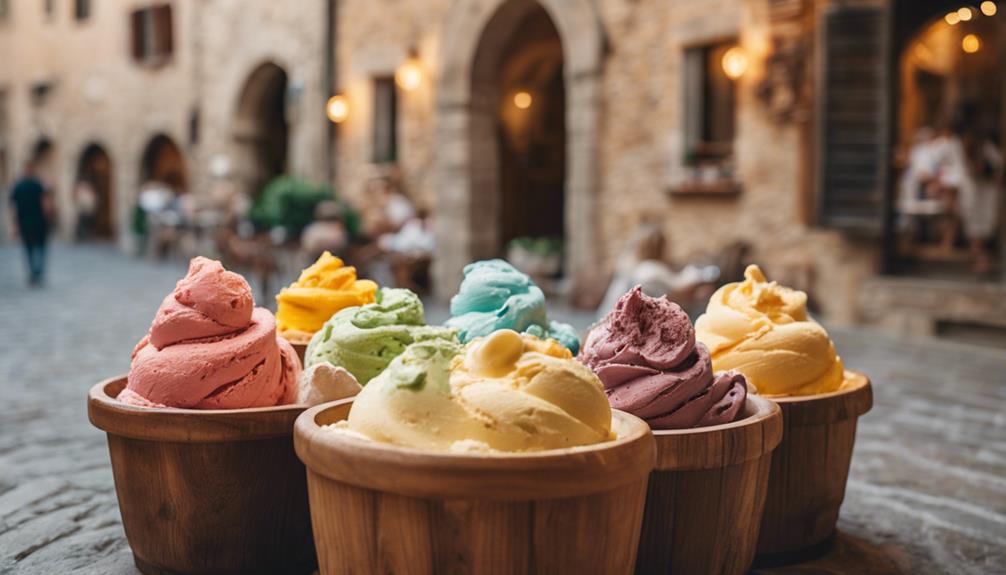Step into the rich history of ice cream, where ancient origins in Persia and Rome set the stage for a delectable evolution over centuries. Explore how iconic figures like Alexander the Great and Nero Claudius Caesar savored early versions, leading to modern indulgences we love today. Discover how cultural influences and culinary exchanges shaped the ice cream we enjoy, from Marco Polo’s sherbet recipe to Sicilian Procopio’s Parisian creation. Uncover the sweet journey of ice cream from humble beginnings to a world-renowned treat that continues to innovate and delight taste buds.
Key Takeaways
- Ice Cream Date is not a historical figure; it refers to a sweet and fun way of enjoying ice cream.
- The term likely originated as a playful way to schedule ice cream outings or gatherings.
- It embodies the joy and nostalgia associated with sharing ice cream with loved ones.
- Ice Cream Date symbolizes a sweet and delightful experience centered around enjoying frozen treats.
- This term reflects the universal love for ice cream and the social aspect of sharing it with others.
Origins of Ice Cream
Ice Cream's origins can be traced back to the second century B.C., with historical figures like Alexander the Great and Nero Claudius Caesar enjoying frozen desserts. The concept of frozen treats made its way to Europe through Marco Polo, who brought a recipe resembling sherbet from the Far East. This exchange of culinary knowledge played an essential role in the development of what we now know as ice cream.
The fascination with frozen desserts continued to evolve over the centuries, eventually reaching North America in the 18th century. The introduction of ice cream in North America is documented in a letter from 1744, marking the beginning of its popularity in the new world. Notable figures like President George Washington and Thomas Jefferson were known to be fans of this sweet indulgence.
The journey of ice cream from a delicacy enjoyed by ancient historical figures to a beloved treat in modern times is a tribute to its enduring appeal and cultural significance.
Evolution of Ice Cream

The journey of frozen treats from ancient historical figures to modern-day indulgences showcases a remarkable evolution in culinary delights. Ice cream has come a long way since its first accounts in the second century B.C., enjoyed by notable figures like Alexander the Great and Nero Claudius Caesar.
The progression continued with Marco Polo introducing a sherbet-like recipe to Europe, leading to Sicilian Procopio's more modern ice cream concoction in Paris. The first ice cream in the New World emerged in 1744, paving the way for its popularity through the 18th and 19th centuries.
As time went on, the evolution of ice cream saw the emergence of the first ice cream maker and the rise of specialty ice cream stores offering unique flavors. The indulgence further evolved with the creation of the iconic ice cream sundae, mesmerizing taste buds worldwide.
Today, the evolution of ice cream is evident in the diverse range of prepackaged options available in supermarkets, showcasing the continuous innovation in this timeless treat.
Ice Cream History

Originating in ancient Persia and Rome, the history of ice cream is intertwined with the indulgent palates of historical figures and the evolution of frozen desserts. Ice cream was invented back in the second century B.C., making its way to America with the first mention in a letter from 1744. It wasn't until the 18th and 19th centuries that ice cream gained popularity, leading to large-scale production starting in 1851. Over time, ice cream has undergone significant changes in flavors, ingredients, and serving styles, reflecting the ever-evolving tastes of society.
Ice cream history is a rich tapestry of cultural influences and technological advancements. From its humble beginnings as a simple frozen treat enjoyed by emperors and conquerors to becoming a staple dessert in households worldwide, ice cream has come a long way. The journey of ice cream production and consumption mirrors the progress of human civilization, proving that this delightful dessert is truly timeless.
Ice Cream Invention

In the ancient world, frozen treats were savored long before they reached the shores of America. The concept of ice cream can be traced back to around 200 B.C. in China, where people enjoyed frozen desserts.
Even historical figures like Alexander the Great were known to indulge in such icy delicacies. However, the first mention of ice cream in the United States dates back to a letter from 1744, showing its early presence in the country.
It wasn't long before ice cream gained popularity among notable figures like George Washington and Thomas Jefferson, who were both enthusiasts of this frozen treat. The real turning point came in 1851 when large-scale ice cream production began in Pennsylvania, marking a significant milestone in the history of this beloved dessert.
From its humble origins to becoming a nationwide favorite, ice cream has come a long way since its invention.
Ice Cream Innovations

You'll be thrilled to discover the latest ice cream trends and innovations that are taking the frozen dessert world by storm.
From unique dairy-free options to experimental flavors, there's always something new to tantalize your taste buds.
Keep your eyes peeled for the next big thing in modern frozen delights!
Trending Ice Cream Innovations
Explore the latest trends in ice cream innovations to discover exciting new flavors and creations that are enchanting dessert enthusiasts worldwide. From dairy-free options to unique cone creations, the world of ice cream is constantly evolving to meet the diverse preferences of consumers.
Here are some trending ice cream innovations to keep an eye on:
- Dairy-Free Delights: With the rise in lactose intolerance and vegan diets, dairy-free ice cream options have become increasingly popular, offering a creamy and delicious alternative for those with dietary restrictions.
- Alternative Options: Ice cream now comes in a variety of alternative options such as coconut milk, almond milk, and even avocado-based varieties, catering to a wide range of tastes and dietary needs.
- Creative Cone Creations: Ice cream cones are no longer limited to the traditional waffle cone. Innovative cone options like chocolate-dipped cones, cookie cones, and even edible cookie dough cones are taking the dessert world by storm.
- Year-Round Indulgence: Thanks to advancements in refrigeration technology, ice cream can now be enjoyed throughout the year, making it a staple dessert regardless of the season.
Modern Frozen Delights
Explore the newest contemporary frozen treats in ice cream innovations that are enchanting dessert enthusiasts globally.
Waffle cones, a delicious invention from 1904, offer a convenient and edible vessel for savoring your favorite ice cream flavors at the local ice cream parlor.
The rise of dairy-free and alternative ice cream varieties caters to a diverse range of dietary preferences, ensuring that everyone can indulge in a scoop of icy goodness.
Thanks to advancements in refrigeration technology, ice cream can now be enjoyed year-round, whether it's a scorching summer day or a chilly winter evening.
The expansion of grocery stores selling ice cream in 1930 brought this beloved frozen delight to a broader audience, making it a household staple.
Soft-serve ice cream, a game-changer from the 1930s, revolutionized the way ice cream is served, offering a smoother and creamier experience for all ice cream enthusiasts.
Ice Cream Facts

The world of ice cream is filled with captivating facts that will surely surprise you. Canadians, for instance, consume an average of 10 liters of ice cream per year, showcasing their love for this frozen treat.
Notably, vanilla stands out as the most popular ice cream flavor globally, loved by many for its simple yet delightful taste. Did you know that soft-serve ice cream, recognized for its smooth texture, was actually invented in the 1930s, revolutionizing the ice cream industry?
Moreover, a single cow can produce enough milk for a whopping 34,000 liters of ice cream in its lifetime, highlighting the immense contribution of dairy animals to this beloved dessert. Amid World War II, ice cream served as a morale booster, bringing a bit of sweetness to challenging times.
These facts shed light on the rich history and impact of ice cream in our lives.
Ice Cream Creation

Let's discuss the captivating world of Ice Cream Creation. You'll uncover the beginnings of your preferred flavors, how ice cream has evolved over time, and the wide range of modern varieties available today.
Get ready to set off on a delightful journey through the history and development of this beloved frozen dessert.
Flavor Origins
Flavor origins in ice cream creation trace back to ancient civilizations, where early versions of these delectable treats delighted historical figures like Alexander the Great and Nero Claudius Caesar.
Here's a glimpse into the fascinating evolution of ice cream flavors:
- Ancient Persia: Ice treats were enjoyed by royalty, with flavors like saffron and rosewater tantalizing the taste buds of Emperor Nero.
- Alexander the Great: Early versions of ice cream were relished by this legendary conqueror, showcasing the diverse flavors available even in ancient times.
- Marco Polo: Introducing a recipe resembling sherbet from the Far East, Polo expanded the flavor palette of ice treats in Europe.
- Sicilian Procopio: His revolutionary blend of milk, cream, and eggs transformed ice cream in Paris, laying the foundation for modern creamy delights.
From the exotic flavors of ancient Persia to the innovative recipes of Marco Polo and Sicilian Procopio, the journey of ice cream flavors continues to captivate taste enthusiasts globally.
Evolution Timeline
Through centuries of creativity and innovation, ice cream has evolved into the beloved frozen treat we enjoy today. The history of ice cream traces back to the second century B.C., with figures like Alexander the Great and Nero Claudius Caesar relishing early versions of frozen desserts.
Marco Polo's introduction of a sherbet-like recipe from the Far East and Sicilian Procopio's blend of milk, cream, butter, and eggs in Paris were pivotal moments in ice cream's evolution.
The New World saw its first ice cream mention in a 1744 letter, leading to the establishment of ice cream production as an industry in America in 1851. The 1874 invention of ice cream soda marked a significant milestone, followed by the transformation of traditional ice cream parlors and soda fountains in the 1940s as the industry embraced new flavors and innovations.
Today, the ice cream industry continues to evolve with specialty stores, supermarket sales, and unique creations, catering to a diverse customer base.
Modern Varieties
In the world of ice cream creation, various modern varieties cater to diverse preferences and dietary needs. When it comes to satisfying your sweet cravings, there are options beyond traditional ice cream that can tantalize your taste buds.
Here are some modern varieties to explore:
- Gelato: This Italian delicacy contains less fat than regular ice cream due to its higher milk content, offering a rich and dense texture that's sure to please.
- Frozen Custard: With the addition of egg yolks, frozen custard boasts a smoother and creamier consistency than typical ice cream, elevating your dessert experience.
- Soft Serve: Known for its light and airy texture, soft serve ice cream is created by incorporating air during freezing, making it a popular choice for cones and sundaes.
- Dairy-Free Options: For those with lactose intolerance or dietary restrictions, dairy-free ice creams made from coconut or almond milk provide a delicious alternative that doesn't compromise on taste.
Whether you're a gelato aficionado, a frozen custard enthusiast, or looking for dairy-free alternatives, the modern ice cream landscape has something for everyone.
Ice Cream Industry Advancements

Technological innovations, such as steam power and mechanical refrigeration, have revolutionized ice cream production in the industry. The invention of insulated ice houses around 1800 further propelled the distribution of ice cream, enabling it to reach a wider audience.
The introduction of mechanical refrigeration not only improved the quality of ice cream but also extended its shelf life, making it more accessible to consumers. In addition, the integration of motorized delivery vehicles transformed the ice cream industry, streamlining distribution processes and reaching more customers efficiently.
With the total annual production of frozen dairy in the U.S. surpassing 6.4 billion pounds, it's evident that the industry has scaled up significantly. As consumer preferences evolve, the ice cream industry continues to innovate, introducing new flavors and creations to cater to a diverse market.
These advancements highlight the industry's commitment to adapt to changing trends and meet the demands of ice cream enthusiasts worldwide.
Ice Cream Global Market

The global ice cream market, valued at $91.3 billion by 2026, showcases significant growth potential in different regions. In the Asia-Pacific region, the ice cream industry holds a substantial market share, indicating a high demand for frozen treats.
North America stands out as a key consumer of premium and artisanal ice cream products, driving innovation and variety in the market. Additionally, the increasing consumer preference for lactose-free and vegan ice cream options is reshaping the industry landscape, encouraging major players to expand their product offerings to cater to diverse dietary needs.
Major players like Unilever, Nestlé, and General Mills are shaping the global market landscape.
Frequently Asked Questions
What Is the Meaning of Ice Cream Date?
An ice cream date is a delightful and romantic outing where you and your special someone enjoy ice cream together. It's a sweet way to bond and create lasting memories over a shared love of this frozen treat.
Where Did the Term Ice Cream Come From?
Ice cream, a term with sweet origins, has been enjoyed for centuries. Its popularity as a fun and nostalgic treat makes it a perfect choice for a delightful date. Sharing an ice cream date can create lasting memories.
Who Made Ice Cream Popular?
Ice cream became popular due to its versatility and delicious taste, appealing to people of all ages. You can thank a mix of factors like social trends, marketing efforts, and the sheer joy it brings to everyone's taste buds!
Who Was the First to Eat Ice Cream?
You were curious about who was the first to eat ice cream. Historical records suggest that figures like Alexander the Great and Nero Claudius Caesar enjoyed early frozen treats, making them likely candidates for this tasty honor.
What Is the Origin of the Term “Ice Cream Date” and Its Connection to the Iconic Ice Cream Song?
The term “Ice Cream Date” is believed to have originated from the practice of couples enjoying ice cream together as a special treat. The iconic ice cream song signal, often played by ice cream trucks, has become associated with happy summer memories and romantic outings, elevating the appeal of the ice cream date experience.
Conclusion
So, next time you go on an 'ice cream date,' remember that you're not just enjoying a frozen treat – you're embracing a delicious tradition that has evolved over centuries.
From the humble origins of ice cream to the modern innovations in the industry, every scoop tells a story.
So scoop up some history and savor the sweetness of a timeless dessert!
















